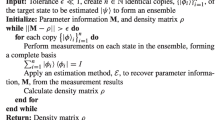Abstract
The following results obtained within a project of finding the algebra of statesin a general-purpose quantum computer are reported: (1) All operations of anorthomodular lattice, including the identity, are fivefold-defined; (2) there arenonorthomodular models for both quantum and classical logics; (3) there is afour-variable orthoarguesian lattice condition which contains all known orthoarguesianlattice conditions including six- and five-variable ones. Repercussions to quantumcomputers operating as quantum simulators are discussed.
Similar content being viewed by others
REFERENCES
Boghosian, B. M., and Taylor, W. (1998). Simulating quantum mechanics on a quantum computer, Physica D 120, 30-42.
Christianson, B., Knight, P. L., and Beth, T. (1998). Implementations of quantum logic, Phil. Trans. R. Soc. Lond. A 356, 1823-1838.
Deutsch, D. (1985). Quantum theory, the Church-Turing principle and the universal quantum computer, Proc. R. Soc. Lond. A 400, 97-117.
Feynman, R. P. (1982). Simulating physics with computers, Int. J. Theor. Phys. 21, 467-488.
Feynman, R. P. (1986). Quantum mechanical computers, Found. Phys. 16, 507-531.
Godowski, R., and Greechie, R. (1984). Some equations related to the states on orthomodular lattices, Demonstratio Math. 17, 241-250.
Grover, L. K. (1997). Quantum computers can search arbitrarily large databases by a single query, Phys. Rev. Lett. 79, 4709-4712.
Holland, Jr., S. S. (1995). Orthomodularity in infinite dimensions; a theorem of M. Sole`r, Bull. Am. Math. Soc. 32, 205-234.
Ivert, P.-A., and Sjo¨din, T. (1978). On the impossibility of a finite propositional lattice for quantum mechanics, Helv. Phys. Acta 51, 635-636.
Kalmbach, G. (1983). Orthomodular Lattices, Academic Press, London.
McKay, B. D., Megill, N. D., and Pavic?ic´, M. (2000). Isomorph-free exhaustive generation of Greechie diagrams and automated checking of their passage of orthomodular lattice equations, Int. J. Theor. Phys., in press.
Maczy?ski, M. J. (1972). Hilbert space formalism of quantum mechanics without the Hilbert space axiom, Rep. Math. Phys. 3, 209-219.
Megill, N. D. and Pavi?ic, M. (2000). Equations and state properties that hold in all closed subspaces of an infinite dimensional Hilbert space, Int. J. Theor. Phys. in press.
Pavi?i?, M. (1987). Minimal quantum logic with merged implications, Int. J. Theor. Phys. 26, 845-852.
Pavi?i?, M. (1993). Nonordered quantum logic and its YES-NO representation, Int. J. Theor. Phys. 32, 1481-1505.
Pavi?i?, M. (1995). Spin-correlated interferometry with beam splitters: Preselection of spincorrelated photons, J. Opt. Soc. Am. B 12, 821-828.
Pavi?i?, M. (1998). Identity rule for classical and quantum theories, Int. J. Theor. Phys. 37, 2099-2103.
Pavi?i?, M., and Megill, N. D. (1998a). Quantum and classical implication algebras with primitive implications, Int. J. Theor. Phys. 37, 2091-2098.
Pavi?i?, M., and Megill, N. D. (1998b). Binary orthologic with modus ponens is either orthomodular or distributive, Helv. Phys. Acta 71, 610-628.
Pavi?i?, M., and Megill, N. D. (1999). Non-orthomodular models for both standard quantum logic and standard classical logic: Repercussions for quantum computers, Helv. Phys. Acta 72, 189-210.
Pavi?i?, M., and Summhammer, J. (1994). Interferometry with two pairs of spin correlated photons, Phys. Rev. Lett. 73, 3191-3194.
Shor, P. W. (1997). Polynomial-time algorithms for prime factorization and discrete logarithms on a quantum computer, SIAM J. Comp. 26, 1484-1509.
Author information
Authors and Affiliations
Rights and permissions
About this article
Cite this article
Pavičić, M. Quantum Logic for Quantum Computers. International Journal of Theoretical Physics 39, 813–825 (2000). https://doi.org/10.1023/A:1003674812809
Issue Date:
DOI: https://doi.org/10.1023/A:1003674812809




